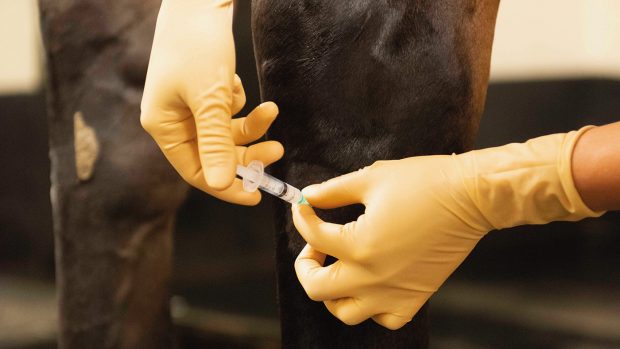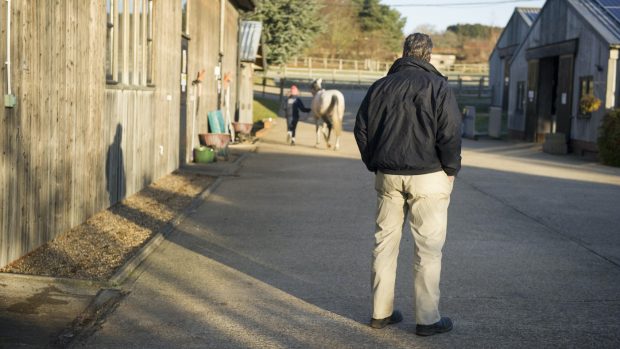It is relatively easy to tell if a horse is lame on a single leg. But if a horse has lameness involving more than one limb — multi-limb lameness — recognition may be much more difficult.
It is quite common for a horse to have the same condition causing lameness in either both fore or hindlimbs (bilateral lameness), and the degree of unsoundness in each limb may be approximately equal. The horse won’t, therefore, show the classical signs of lameness, such as bobbing the head or dragging the hind toe.
Signs of multi-limb lameness
If both forelimbs are affected, the rider may realise that the horse is not striding as freely as before. It may feel restricted in the shoulders, although it is much more likely that the source of pain is in the lower parts of the legs.
A dressage horse may appear normal in working and collected gaits, but may lose the quality of its extended paces. A jumping horse may start to put in short strides on the approach to a fence, or may start stopping or struggle to make the distances in combination fences. An event horse may be reluctant to jump drop fences. A riding horse may be unwilling to walk straight down hills and tend to go crooked.
If both hindlimbs are affected, the horse will show loss of engagement and impulsion. It may work more on the forehand and appear to hold its back stiffly. The horse may be unwilling to work properly on the bit and some hindlimb unlevelness might be seen in medium and extended trot. If asked to push more from behind, a horse might prefer to break into canter. A jumping horse may lose power and find it hard to jump large spreads. Dressage horses may become resistant or even appear nappy.
The clinical signs may be gradual in onset and it could be some time before the rider appreciates that there is a problem. The signs are rather non-specific, and are often erroneously attributed to back pain. Affected horses often have some secondary back muscle soreness, but that is not the primary cause of the performance problem. Physiotherapy treatment may relieve the back pain, but, unless the primary problem is identified and treated, the improvement will be short-lived.
Diagnosis of multi-limb lameness
These cases can be hard to recognise, since many are mistakenly considered to be riding issues. Unless you know how the horse used to move it may at first appear to be going normally.
To make a diagnosis, the vet has to listen carefully to the owner and obtain clues as to the nature of the problem and its possible causes. Investigation is a process of elimination of a list of problems that can look similar. An experienced equine vet, used to dealing with lameness, may pick up clues, such as flexion tests that cause obvious lameness.
Seeing the horse lunged on soft and hard surfaces may enable a definite unsoundness to be detected. If the horse has bilateral (both limbs) forelimb lameness, it may become apparent when it is lunged on a firm surface.
Alternatively, there may be no obvious lameness, but the horse may take shorter strides when lunged on a hard surface compared with a soft one. It may become less balanced and tend to lean in and look out, rather than bend in the direction of the circle.
With bilateral hindlimb lameness, toe drag or lameness may become evident on the lunge, especially on a softer surface. Seeing the horse ridden in small figures of eight may reveal hindleg unlevelness as it changes direction.
The vet’s first priority is to try to determine the sources of pain. Only then can you proceed with further investigation, such as X-rays or ultrasound scans. It is helpful to be aware of the conditions that often cause pain in both limbs simultaneously, such as the many causes of front foot pain, osteoarthritis of the lower hock joints or proximal suspensory desmitis in hindlimbs.
If the horse shows a shortened forelimb stride but no obvious lameness, it is possible that by desensitising one front foot using nerve blocks and thus relieving pain, lameness may become apparent in the other leg. This lameness may also be abolished by nerve blocks of the foot. The horse can then move with much greater freedom.
Although you might expect this to happen with any horse with bilateral (left and right) foot pain, curiously, it doesn’t always. Sometimes it is necessary to block both front feet simultaneously before any change in the horse’s action can be appreciated.
It is always important that the rider rides the horse after the nerve blocks so that he can assess whether it is performing as it used to. This is particularly true when assessing a horse with bilateral hindlimb lameness, or loss of hindlimb power.
In these cases, the most obvious change in the horse’s way of going is when the source of pain in both limbs is blocked out. A horse that was previously being evasive and reluctant to take a true contact may be completely transformed and now move with greatly improved hindlimb impulsion and engagement, increased swing through the back, increased lift to the forehand and a better quality contact.
Lame in front and behind
Another manifestation is the presence of both forelimb and hindlimb lameness, which can affect any combination of limbs. It may be easier to recognise that the horse is lame in front and behind than one which is lame on both front or both back legs.
Deciding which is the lame limb may be more challenging. This is particularly true if the horse has moderately severe hindlimb lameness because this can induce a head nod that mimics forelimb lameness. A horse with left hindlimb pain may nod its head when the left hindlimb and right forelimb are bearing weight, thus imitating left forelimb lameness.
If the nod is much worse when the horse is lunged in a circle, but the hindlimb lameness looks no worse, then it is likely that the horse actually has simultaneous left forelimb and left hindlimb lameness. If the nod does not change, it may be solely due to hindlimb lameness. It may only be after successfully nerve blocking the left hindlimb and abolishing the lameness that it can be seen whether or not the head nod reflects forelimb or hindlimb lameness.
Clearly it is very complicated, but multi-limb lameness is quite common. Approximately 75% of horses referred to the Animal Health Trust for investigation have lameness in more than one limb. These difficult manifestations of lameness need considerable time and expertise to unravel the causes. You need the help of a specialist equine vet used to dealing with performance horses. Be prepared for the investigations to take several days before a conclusive answer is reached and you can begin to discuss treatment and prognosis.
- This veterinary feature was first published in Horse & Hound (26 May, ’05)




